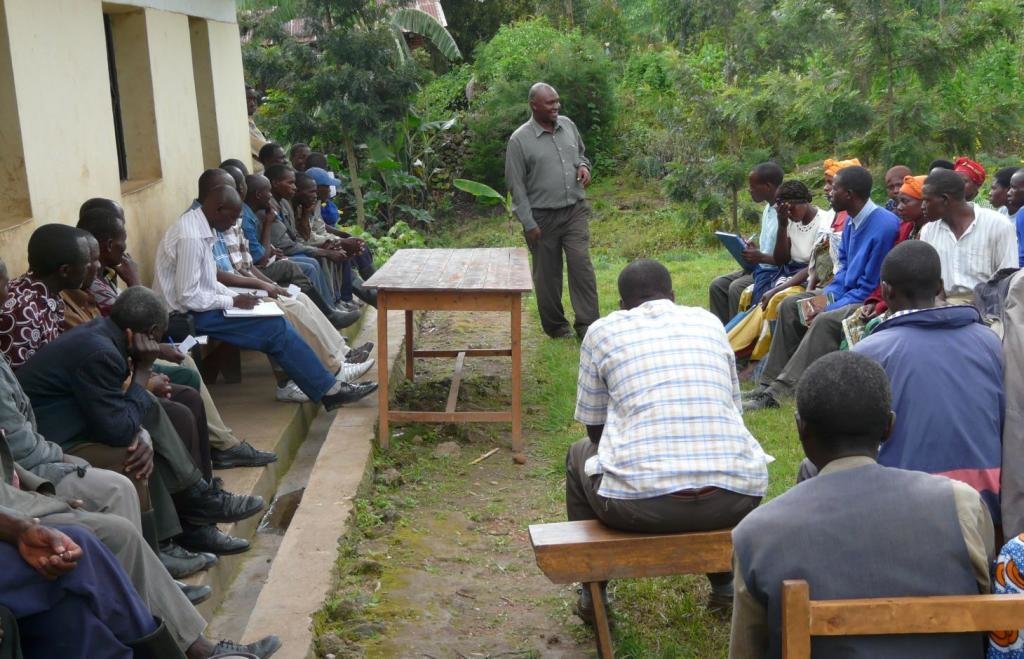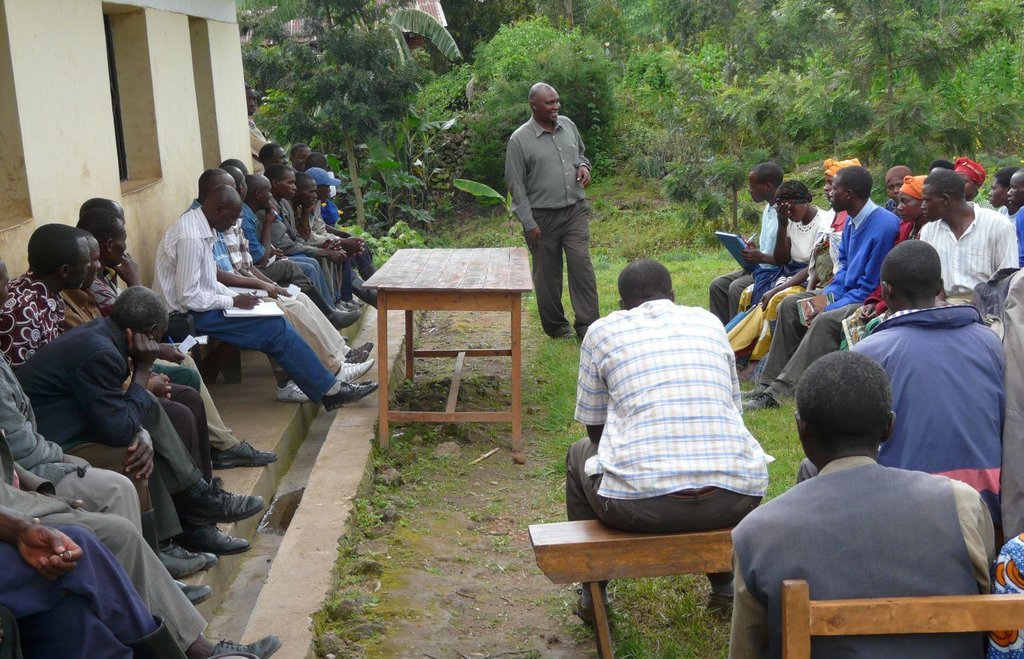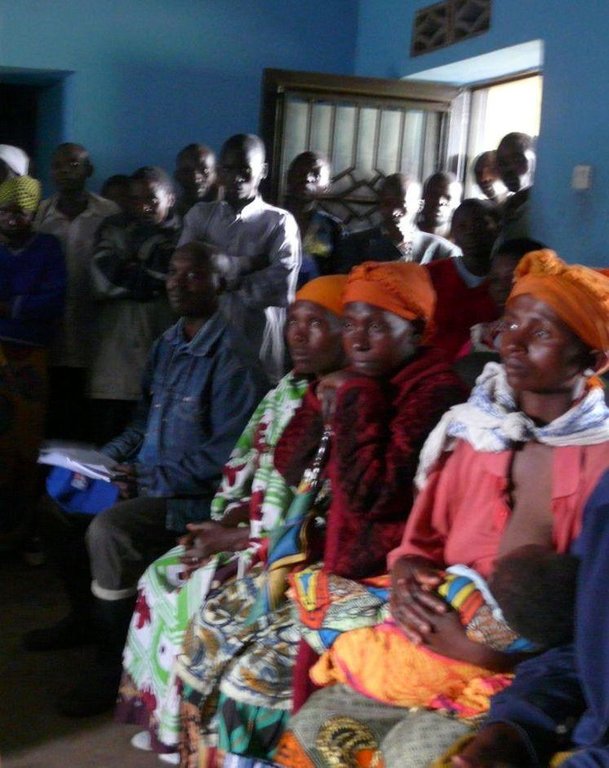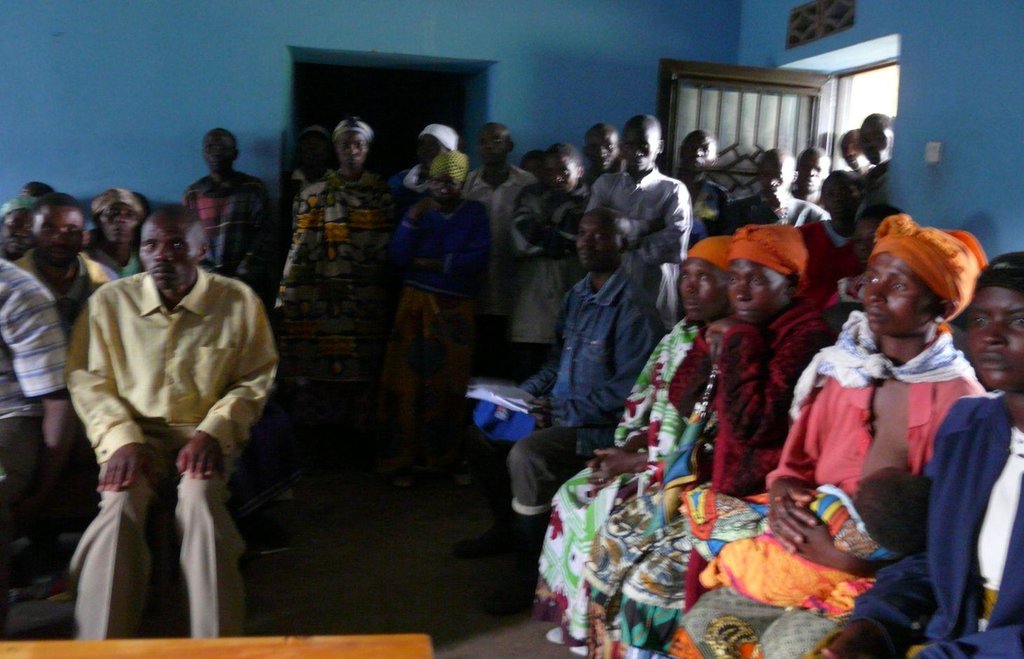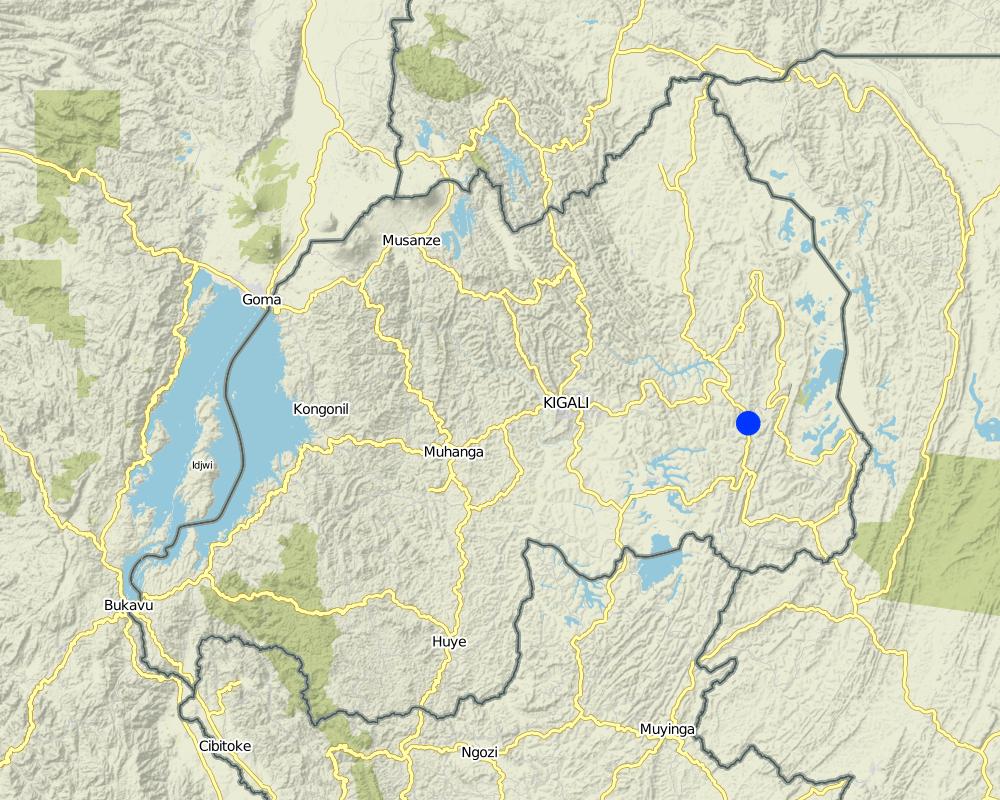Participatory approach [รวันดา]
- ผู้สร้างสรรค์:
- การอัพเดท:
- ผู้รวบรวม: Desire Kagabo
- ผู้เรียบเรียง: –
- ผู้ตรวจสอบ: David Streiff
Ubufatanye bwinzego zose
approaches_2584 - รวันดา
ดูส่วนย่อย
ขยายทั้งหมด ย่อทั้งหมด1. ข้อมูลทั่วไป
1.2 รายละเอียดที่ติดต่อได้ของผู้รวบรวมและองค์กรที่เกี่ยวข้องในการประเมินและการจัดเตรียมทำเอกสารของแนวทาง
ผู้เชี่ยวชาญ SLM:
ผู้เชี่ยวชาญ SLM:
Muligirwa MULIGIRWAEmmanuel
ชื่อของโครงการซึ่งอำนวยความสะดวกในการทำเอกสารหรือการประเมินแนวทาง (ถ้าเกี่ยวข้อง)
The Transboundary Agro-ecosystem Management Project for the Kagera River Basin (GEF-FAO / Kagera TAMP )ชื่อของโครงการซึ่งอำนวยความสะดวกในการทำเอกสารหรือการประเมินแนวทาง (ถ้าเกี่ยวข้อง)
Food and Agriculture Organization of the United Nations (FAO) - อิตาลีชื่อของโครงการซึ่งอำนวยความสะดวกในการทำเอกสารหรือการประเมินแนวทาง (ถ้าเกี่ยวข้อง)
Rwanda Agriculture Board (Rwanda Agriculture Board) - รวันดา1.3 เงื่อนไขที่เกี่ยวข้องกับการใช้ข้อมูลที่ได้บันทึกไว้ผ่านทาง WOCAT
วันที่เก็บรวบรวมข้อมูล (ภาคสนาม):
06/05/2014
ผู้รวบรวมและวิทยากรหลักยอมรับเงื่อนไขเกี่ยวกับการใช้ข้อมูลที่ถูกบันทึกผ่านทาง WOCAT:
ใช่
1.4 การอ้างอิงถึงแบบสอบถามเรื่องเทคโนโลยี SLM
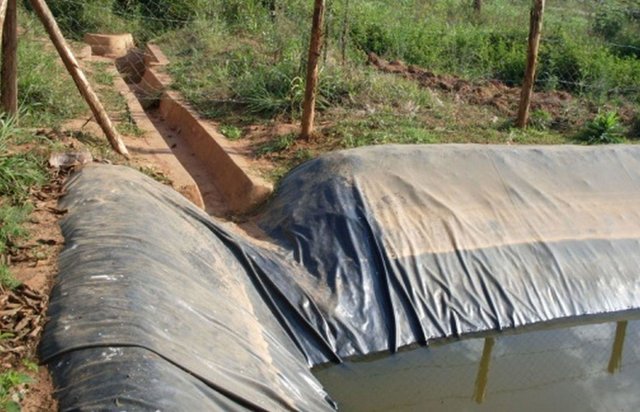
Lining geomembrane plastics for water harvesting and storage [รวันดา]
Lining geomembrane plastic for water harvesting and storage is a rainwater harvesting technique used by land users to collect rain water or runoff from a concave watershed to a common well-structured plastic-lined pond for agricultural, domestic and other use.
- ผู้รวบรวม: Iwona Piechowiak
2. คำอธิบายของแนวทาง SLM
2.1 การอธิบายแบบสั้น ๆ ของแนวทาง
This approach is a contribution of different stakeholders and land users in the identification and resolution of a particular crop land problems, which implicate at the end different stage of intervention by all stakeholders to resolve the problem.
2.2 การอธิบายอย่างละเอียดของแนวทาง
การอธิบายอย่างละเอียดของแนวทาง:
Aims / objectives: The main goal of the approach is to plan and implement land management activities with villagers in such a way that sustainability is ensured. The specific objectives of the project are to:
(1) increase the capacity of the villagers to design, implement and self-evaluate Soil and water management activities.(2) improve crop production by limiting the effect of dry season during the critical stage of crop growth at the beginning of dry season.
Methods: This approach is integral to the Ministry of Agriculture and Animal Husbandry(MINAGRI) through a long-term project, which was initiated in 2005 and has been financed mainly by the government, with two different part of intervention of farmers which can be a voluntary participation and contributions of the local population or based on food for work.
Stages of implementation: Project extension work is carried out by facilitators from MINAGRI and consists of awareness raising and demonstration.
Problem identification and planning of activities takes place in village meetings. The local land users are supported by MINAGRI personnel who also provide technical and other facilities assistance during the implementation of Soil and Water Conservation measures
2.3 รูปภาพของแนวทาง
2.5 ประเทศ ภูมิภาค หรือสถานที่ตั้งที่ได้นำแนวทางไปใช้
ประเทศ:
รวันดา
ภูมิภาค/รัฐ/จังหวัด: :
East
ข้อมูลเฉพาะเพิ่มเติมของสถานที่ตั้ง:
Kayonza
ความคิดเห็น:
The area is not well known it is approximately determined by land users and local authorities.
Map
×2.6 วันที่เริ่มต้นและสิ้นสุดของแนวทาง
ระบุปีที่เริ่ม:
2005
2.7 ประเภทของแนวทาง
- local government, diferents stakeholders and land user.
2.8 เป้าหมายหรือวัตถุประสงค์หลักของแนวทาง
The Approach focused mainly on SLM with other activities (Reduce sedimentation and irrigation)
Design, test and disseminate alternative technologies adapted to local conditions - strengthen local knowledge of soil and water management measures.
The SLM Approach addressed the following problems: The lack of appropriate ways to develop sustainable technologies to remedy loss of runoff water and poor crop growth in the context of low-input agriculture on gentle undulating land in water scarce areas with an absence of soil conservation measures.
2.9 เงื่อนไขที่เอื้ออำนวยหรือเป็นอุปสรรคต่อการนำเทคโนโลยีภายใต้แนวทางนี้ไปปฏิบัติใช้
การมีไว้ให้หรือการเข้าถึงแหล่งการเงินและบริการ
- เป็นอุปสรรค
Water harvesting is considered expensive due to material (mainly laying plastic sheet) and labour cost.
Treatment through the SLM Approach: Identification of a low-cost water harvesting measure, which can be implemented during the off-season. Cost-benefit analysis.
ความรู้เกี่ยวกับ SLM การเข้าถึงการสนับสนุนด้านเทคนิค
- เป็นอุปสรรค
Difficulty in tilling the land when water harvesting structures are in place.
Treatment through the SLM Approach: Integrating new technologies and local knowledge of farmers about the market, into growing more profitable crops (cash crops).
3. การมีส่วนร่วมและบทบาทของผู้มีส่วนได้ส่วนเสียที่เกี่ยวข้อง
3.1 ผู้มีส่วนได้ส่วนเสียที่เกี่ยวข้องในแนวทางนี้และบทบาท
- ผู้ใช้ที่ดินระดับท้องถิ่นหรือชุมชนระดับท้องถิ่น
Decision making
- องค์กรที่ขึ้นอยู่กับชุมชน
- ผู้เชี่ยวชาญ SLM หรือที่ปรึกษาการเกษตร
- รัฐบาลระดับท้องถิ่น
- รัฐบาลแห่งชาติ (ผู้วางแผน ผู้ทำการตัดสินใจ)
- องค์การระหว่างประเทศ
3.2 การเกี่ยวข้องของผู้ใช้ที่ดินระดับท้องถิ่นหรือชุมชนระดับท้องถิ่นในช่วงต่างๆของแนวทาง
| ความเกี่ยวข้องของผู้ใช้ที่ดินระดับท้องถิ่นหรือชุมชนระดับท้องถิ่น | ระบุผู้ที่มีส่วนเกี่ยวข้องและอธิบายกิจกรรม | |
|---|---|---|
| การริเริ่มหรือการจูงใจ | ปฏิสัมพันธ์ | |
| การวางแผน | ปฏิสัมพันธ์ | |
| การดำเนินการ | จ่ายเงินหรือสนับสนุนจากภายนอก | |
| การติดตามตรวจสอบหรือการประเมินผล | ปฏิสัมพันธ์ | |
| Research | ปฏิสัมพันธ์ |
3.4 การตัดสินใจเลือกใช้เทคโนโลยี SLM
ระบุผู้ที่ทำการตัดสินใจเลือกเทคโนโลยีมากกว่าหนึ่งวิธีไปปฏิบัติใช้:
- ผู้เชี่ยวชาญ SLM เป็นผู้ตัดสินใจหลัก ที่ติดตามให้คำปรึกษากับผู้ใช้ที่ดิน
การอธิบาย:
Decision were mad by land users and stakeholders.
Decisions on the method of implementing the SLM Technology were made by mainly by SLM specialists with consultation of land users
4. การสนับสนุนด้านเทคนิค การสร้างขีดความสามารถ และการจัดการด้านความรู้
4.1 การสร้างขีดความสามารถ / การอบรม
ได้มีการจัดอบรมให้แก่ผู้ใช้ที่ดินหรือผู้มีส่วนได้ส่วนเสียคนอื่น ๆ หรือไม่:
ใช่
ให้ระบุว่าใครเป็นผู้ได้รับการอบรม:
- ผู้ใช้ที่ดิน
- เจ้าหน้าที่ภาคสนาม / ที่ปรึกษา
รูปแบบการอบรม:
- ใช้พื้นที่ทำการสาธิต
4.2 การบริการให้คำแนะนำ
ผู้ใช้ที่ดินมีการเข้าถึงการรับบริการให้คำปรึกษาหรือไม่:
ใช่
ระบุว่ามีบริการให้คำปรึกษาหรือไม่:
- ไปเยี่ยมชมสถานที่
การอธิบาย/แสดงความคิดเห็น:
Advisory service is quite adequate to ensure the continuation of land conservation activities; Land users are 100% willing to upscale the technology but they are financially not strong enough and unstable.
4.3 การเสริมความแข็งแกร่งให้กับสถาบัน (การพัฒนาองค์กร)
สถาบันได้รับการจัดตั้งขึ้นมาหรือเสริมความแข็งแกร่งโดยแนวทางนี้หรือไม่:
- ไม่
4.4 การติดตามตรวจสอบและประเมินผล
การติดตามตรวจสอบและประเมินผลเป็นส่วนหนึ่งของแนวทางหรือไม่:
ใช่
ความคิดเห็น:
bio-physical aspects were ad hoc monitored by government through observations
bio-physical aspects were regular monitored by government through measurements
technical aspects were ad hoc monitored by government through observations
technical aspects were regular monitored by government through measurements
socio-cultural aspects were ad hoc monitored by government and land users through observations
no. of land users involved aspects were regular monitored by government and land users through measurements
management of Approach aspects were regular monitored by government through observations
There were no changes in the Approach as a result of monitoring and evaluation
There were few changes in the Technology as a result of monitoring and evaluation: Land users are trying to organise themselves to implement the technology although it is expensive.
4.5 การวิจัย
การวิจัยเป็นส่วนหนึ่งของแนวทางหรือไม่:
ใช่
ระบุหัวข้อเรื่อง:
- สังคมวิทยา
- เศรษฐศาสตร์หรือการตลาด
- เทคโนโลยี
ให้ข้อมูลเพิ่มเติมและให้ระบุผู้ทำการวิจัย:
Research was carried out on-farm
5. การสนับสนุนด้านการเงินและวัสดุอุปกรณ์
5.1 ระบุงบประมาณประจำปีสำหรับแนวทาง SLM นี้
ถ้าหากว่างบประมาณประจำปีไม่เป็นที่ทราบแน่นอน ให้ระบุช่วงลงไป:
- 10,000-100,000
แสดงความคิดเห็น (แหล่งของการระดมทุน ผู้บริจาคคนสำคัญ):
Approach costs were met by the following donors: government: 40.0%; international non-government: 40.0%; local government (district, county, municipality, village etc): 15.0%; local community / land user(s): 5.0%
5.2 การสนับสนุนด้านการเงิน / วัสดุอุปกรณ์ให้แก่ผู้ใช้ที่ดิน
ผู้ใช้ที่ดินได้รับการสนับสนุนด้านการเงิน / วัสดุอุปกรณ์ไปปฏิบัติใช้เทคโนโลยีหรือไม่:
ใช่
ถ้าใช่ ให้ระบุประเภทของการสนับสนุน เงื่อนไขและผู้จัดหามาให้:
Care international provided funds (food for work) and the local government provided some equipments (plastic sheets) research staffs and means and training.
5.3 เงินสนับสนุนสำหรับปัจจัยนำเข้า (รวมถึงแรงงาน)
- วัสดุสำหรับการก่อสร้าง
| ระบุปัจจัยนำเข้าที่ได้รับการสนับสนุน | เห็นด้วยระดับไหน | ระบุเงินสนับสนุน |
|---|---|---|
| plastic sheets, ciment and fencing wires | ได้รับการช่วยเหลือทางการเงินแบบเต็ม | |
ถ้าแรงงานโดยผู้ใช้ที่ดินเป็นปัจจัยนำเข้าที่มีอยู่มากมาย ระบุด้วยว่าเนื่องจาก:
- อาหารสำหรับการทำงาน
ความคิดเห็น:
Initial stage of implementation were funded by Care and the last stage were done voluntary (maintenance).
5.4 เครดิต
มีการจัดหาเครดิตมาให้ภายใต้แนวทาง SLM หรือไม่:
ไม่ใช่
6. การวิเคราะห์ผลกระทบและการสรุป
6.1 ผลกระทบของแนวทาง
ช่วยให้ผู้ใช้ที่ดินนำเอาเทคโนโลยี SLMไปใช้และบำรุงรักษาสภาพไว้ได้หรือไม่:
- ไม่ใช่
- ใช่ เล็กน้อย
- ใช่ ปานกลาง
- ใช่ อย่างมาก
Did other land users / projects adopt the Approach?
- ไม่ใช่
- ใช่ เล็กน้อย
- ใช่ ปานกลาง
- ใช่ อย่างมาก
Other land users around the technology adapted the technology in their land after being convinced by its importance.
Did the Approach lead to improved livelihoods / human well-being?
- ไม่ใช่
- ใช่ เล็กน้อย
- ใช่ ปานกลาง
- ใช่ อย่างมาก
Did the Approach help to alleviate poverty?
- ไม่ใช่
- ใช่ เล็กน้อย
- ใช่ ปานกลาง
- ใช่ อย่างมาก
6.2 แรงจูงใจหลักของผู้ใช้ที่ดินเพื่อที่จะนำ SLM ไปปฏิบัติใช้
- การผลิตที่เพิ่มขึ้น
To increase crop production
- กำไร (ความสามารถ) อัตราส่วนค่าใช้จ่ายต่อผลประโยชน์ที่เพิ่มขึ้น
To grow profitable crop like vegetables
- well-being and livelihoods improvement
Reduce povertty by increasing anual incom
6.3 ความยั่งยืนของกิจกรรมของแนวทาง
ผู้ใช้ที่ดินสามารถทำให้สิ่งต่างๆ ที่ได้ปฏิบัติใช้โดยแนวทางนี้ยั่งยืนได้หรือไม่ (โดยไม่มีการสนับสนุนจากภายนอก):
- ใช่
ถ้าตอบว่าใช่ ให้อธิบายว่าอย่างไร :
It has create good interaction between land users and other stakeholders.
6.4 จุดแข็งและข้อได้เปรียบของแนวทาง
| จุดแข็ง / ข้อได้เปรียบของแนวทางในทัศนคติของผู้ใช้ที่ดิน |
|---|
| Building of local knowledge (How to sustain/ enhance this strength: strengthen sensitization by the government) |
| Engagement of researchers with local innovators and thus interaction between scientific and indigenous knowledge (How to sustain/ enhance this strength: This approach can only be sustained if it is mainstreamed into national research and extension services.) |
| จุดแข็ง / ข้อได้เปรียบของแนวทางในทัศนคติของผู้รวบรวมหรือวิทยากรหลัก |
|---|
| Capacity building of both land users and researchers (How to sustain/ enhance this strength: strengthen the interaction between SLM specialist and land uses by the government) |
6.5 จุดอ่อน / ข้อเสียเปรียบของแนวทางและวิธีในการแก้ไข
| จุดอ่อน / ข้อเสียเปรียบในทัศนคติของผู้รวบรวมหรือวิทยากรหลัก | สามารถแก้ไขปัญหาได้อย่างไร |
|---|---|
| Appropriate facilitating skills required | Mainstreaming facilitation skills. |
| Time demanding | Less time needed after the first steps of implementation |
7. การอ้างอิงและการเชื่อมต่อ
7.1 วิธีการหรือแหล่งข้อมูล
- ไปเยี่ยมชมภาคสนาม การสำรวจพื้นที่ภาคสนาม
- การสัมภาษณ์กับผู้ใช้ที่ดิน
7.3 เชื่อมโยงกับข้อมูลที่มีอยู่บนออนไลน์
ชื่อเรื่องหรือคำอธิบาย:
Kagera TAMP Project website
URL:
http://www.fao.org/in-action/kagera/home/en/
ลิงก์และโมดูล
ขยายทั้งหมด ย่อทั้งหมดลิงก์

Lining geomembrane plastics for water harvesting and storage [รวันดา]
Lining geomembrane plastic for water harvesting and storage is a rainwater harvesting technique used by land users to collect rain water or runoff from a concave watershed to a common well-structured plastic-lined pond for agricultural, domestic and other use.
- ผู้รวบรวม: Iwona Piechowiak
โมดูล
ไม่มีโมดูล



